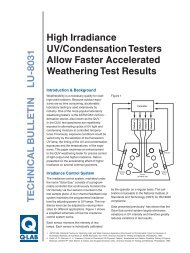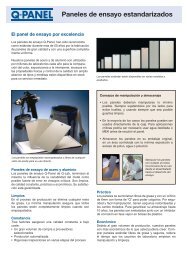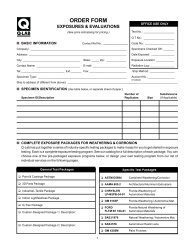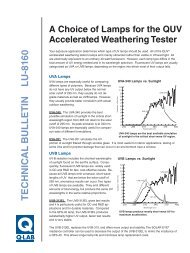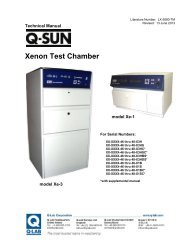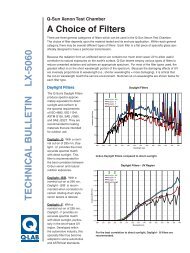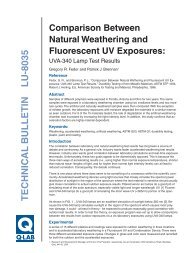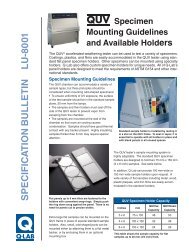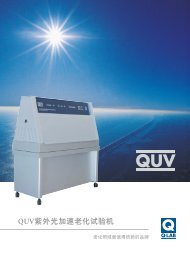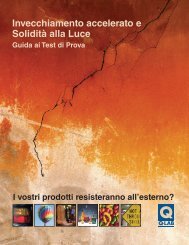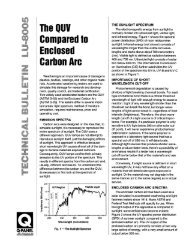Introduction to Cyclic Corrosion Testing - Q-Lab
Introduction to Cyclic Corrosion Testing - Q-Lab
Introduction to Cyclic Corrosion Testing - Q-Lab
You also want an ePaper? Increase the reach of your titles
YUMPU automatically turns print PDFs into web optimized ePapers that Google loves.
<strong>Cyclic</strong> corrosion testing is intended <strong>to</strong> produce<br />
failures representative of the type found in<br />
outdoor corrosive environments. CCT tests<br />
expose specimens <strong>to</strong> a series of different<br />
environments in a repetitive cycle. Simple<br />
exposures like Prohesion may consist of cycling<br />
between salt fog and dry conditions. More<br />
sophisticated au<strong>to</strong>motive methods call for multistep<br />
cycles that may incorporate immersion,<br />
humidity, condensation, along with salt fog<br />
and dry-off. Originally, these au<strong>to</strong>motive test<br />
procedures were designed <strong>to</strong> be performed by<br />
hand. <strong>Lab</strong>ora<strong>to</strong>ry personnel manually moved<br />
samples from salt spray chambers <strong>to</strong> humidity<br />
chambers <strong>to</strong> drying racks, etc. More recently,<br />
microprocessor controlled chambers have been<br />
used <strong>to</strong> au<strong>to</strong>mate these exposures and reduce<br />
variability.<br />
Exposure Environments<br />
Any or all of the following environments may be<br />
used for cyclic corrosion testing.<br />
Ambient Environment: As used in CCT procedures<br />
this term means labora<strong>to</strong>ry ambient conditions.<br />
Ambient environments are usually used as a<br />
way <strong>to</strong> very slowly change the test sample’s condition.<br />
For example, the sample is sprayed with<br />
salt solution and allowed <strong>to</strong> dwell at “ambient” for<br />
two hours. The sample is actually going through a<br />
very slow dry-off cycle while subject <strong>to</strong> a particular<br />
temperature and humidity.<br />
Typically, “ambient environments” are free of corrosive<br />
vapors and fumes. There is little or no air<br />
movement. Temperature is usually 25 ± 5°C. Relative<br />
humidity is 50% or less. The ambient conditions<br />
should be moni<strong>to</strong>red and recorded for each<br />
test.<br />
Chamber Environments: Non-ambient environments<br />
are usually chamber exposures. Cycling<br />
between different non-ambient environments<br />
can be performed by physically moving the test<br />
specimens from one chamber <strong>to</strong> another or, in au<strong>to</strong>mated<br />
chambers, by cycling from one condition<br />
<strong>to</strong> another.<br />
The temperature and relative humidity should be<br />
moni<strong>to</strong>red. Whenever possible, au<strong>to</strong>matic control<br />
systems should be used. Temperature <strong>to</strong>lerances<br />
should be ±3°C or better.<br />
11. D 2247, Practice for <strong>Testing</strong> Water Resistance of Coatings in 100% Relative Humidity.<br />
12. D 1193, Specification for Reagent Water.<br />
Fog (Spray) Environment: Salt fog application<br />
can take place in a B117 type test chamber or be<br />
done by hand in a labora<strong>to</strong>ry ambient environment.<br />
The fog nozzle should be such that the solution<br />
is a<strong>to</strong>mized in<strong>to</strong> a fog or mist. Commonly, in<br />
addition <strong>to</strong> NaCl, the electrolyte solution contains<br />
other chemicals <strong>to</strong> simulate acid rain or other industrial<br />
corrosives. Figure 2 shows a chamber in<br />
the fog mode.<br />
Humid Environment: CCT procedures often<br />
call for high humidity enviroments. Typically they<br />
specify 95 <strong>to</strong> 100% RH. These may be achieved<br />
by using ASTM D 2247. 11 As an alternative, a B<br />
117 chamber may sometimes be used <strong>to</strong> apply a<br />
pure water fog. Figure 3 shows a Q-Fog operating<br />
in the humidity mode.<br />
Dry-Off Environment: A dry-off environment<br />
may be achieved in an open labora<strong>to</strong>ry or inside<br />
a chamber. The area should be maintained with<br />
enough air circulation <strong>to</strong> avoid stratification and <strong>to</strong><br />
allow drying of the material. The definition of “dryoff”<br />
can be problematic. There is disagreement<br />
on whether a specimen should be considered dry<br />
when the surface is dry, or when the specimen has<br />
dried throughout. As corrosion products build up,<br />
the time necessary <strong>to</strong> achieve full dry-off may increase.<br />
Figure 4 shows Q-Fog dry-off.<br />
Corrosive Immersion Environment: This environment<br />
would normally consist of an aqueous<br />
solution with an electrolyte at a specified concentration,<br />
typically up <strong>to</strong> 5%. Typical pH is 4 <strong>to</strong> 8 and<br />
temperature is usually specified. The solution will<br />
become contaminated with use, so it should be<br />
changed on a regular basis.<br />
Water Immersion Environment: Distilled or<br />
deionized water should be used. ASTM D 1193 12<br />
provides useful guidance on water purity. The immersion<br />
container should be made of plastic or<br />
other inert material. Acidity of the bath should be<br />
within a pH range of 6 <strong>to</strong> 8. Temperature should be<br />
24°C ±3°C. Conductivity should be < 50 mmho/<br />
cm at 25°C.



